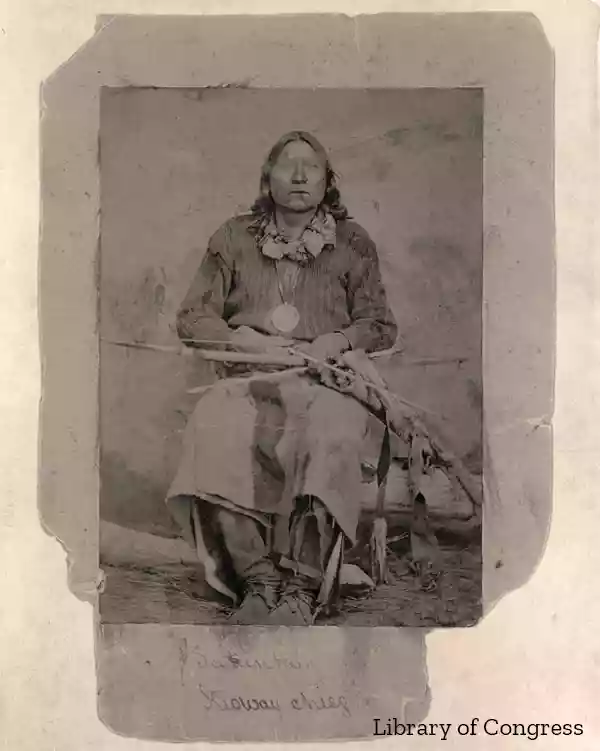
Satanta of the Kiowa Nation
Satanta (or White Bear) was born in 1820, the son of red Tipi, a prominent Kiowa and the keeper of the Tai-me, the tribal medicine bundles. The Kiowa nation, numbering less than just two thousand members produced many notable warriors, and Satanta figured prominently among them. From the period of 1820 to the late 1870’s, the Kiowa nation lived a nomadic life across the Midwest plains. Their principal hunting grounds and territory would stretch from the Rio Grande (and over into Mexico on occasion) to as far north as the upper Kansas Territory.
Among the Indian nations of the Midwest, a tribe’s prestige was measured by the size of their horse herds and their fierceness in battle, and the Kiowa were second only to the Comanche in both categories. At a young age Satanta stood out among the other braves for his charisma and oratory skills. By his early twenties he stood six feet tall, was heavily muscled and darkly tanned by the sun. A famous and prominent Kiowa Chief, Black Horse, granted him even more prestige by giving him his shield.
Kiowa shields were made of several layers of thick buffalo hide and wooden sticks to give them shape. They weren’t particularly useful against bullets or arrows, but the Kiowa believed that shields were imbued with strong supernatural protection and so this gift testified to Black Horses conviction that Satanta would be a great warrior. Black Horse had carried the shield into battle many times and had always escaped unharmed, and ironically, he was killed soon after giving the shield to Satanta.
Satanta carried the shield with him into battle, and while in Chihuahua Mexico, he was roped off his horse by a vaquero and would have been dragged to death had he not escaped with the aid of two other warriors and, as he proclaimed, the blessings and protection of his shield.
Dohausan was the appointed Chief of the Kiowa, but by the 1840’s, Satanta was equal in influence among the tribe, and was more flamboyant and charismatic. Using the shield as a symbol of his good fortune, it was hung high in the place of honor in his medicine lodge when not being carried into battle.
Troubles began as early as 1845, when Texas, upon becoming a state, began attracting larger numbers of settlers, who invaded lands the Kiowa claimed as hunting grounds. The settlers would cut down timber and hunters would slaughter large numbers of buffalo for their hides, leaving the meat to rot in the prairie sun.In retaliation for these affronts, the Kiowas, as well as the Comanche began to strike back, killing, taking scalps and capturing large horse herds from settlers. In 1859, Indian Agents reported a “smoldering passion for revenge” from the Indians at the theft of their land by whites.
In 1864 at U.S. Army Fort Larned Kansas, Satanta and another warrior approached the gate to enter but were denied by the sentry. Angered, Satanta was so fast that he put two arrows into the sentry before the sentry could return fire. Knowing the troops would pursue his people, he gave the tribe time to tear down camp and move by attacking the fort, which had assumed the Indians would flee and he and his warriors ran off the garrison’s horses. To add insult to injury Satanta sent a letter to the Post Commander three days later stating that he “hoped the fort would get better horses in the future, because the ones he had captured from the fort were inferior to the horses he already possessed!”
Neither the Union or Confederacy had been in possession of the resources or the time to deal with the Indian attacks on settler encroaching into land regarded by the tribes as theirs. Both governments had made repeated threats but because there had never been any action taken the tribes felt that the governments were scared of them. Indians of the Plains believed in dealing with others and each other from a position of strength, and believed the whites would back down or bargain and they were correct for a time.In 1867 Congress sent a peace commission to make peace with the southern plains tribes, presumably to remove all cause for warfare. To guarantee the safety of the Indians coming to attend, troops from Fort Larned were sent to escort the tribes to Medicine Lodge Creek, Kansas — approximately 5,000 Kiowa, Comanche, Kiowa Apache, Southern Cheyenne, and Arapahoe. While enroute with their escort, the column came across a herd of Buffalo, and many of the white troopers and civilians rushed out and killed them for sport, leaving the carcasses where they fell. This infuriated Satanta who immediately complained to the Indian Agent and the Peace Commission.At the meeting, the Commissioners wanted the Indians to settle on reservations and told the Indians they would provide food and shelter.
When Satanta spoke, his eloquence, stature and presence impressed everyone as he spoke about not wanting to settle, how he loved to roam the prairies as his fathers had done for generations. He said that he spoke no lies and held nothing in secret and hoped that the commissioners would be as honest. As most peace talks went, the treaty demanded they give up land, move to reservations and that military troops would enforce leaving the reservations. The Indians could not read the documents but believed the things they protested the most about had been granted, and only hearing the promises of food, medicine and teaching, and the gifts presented to the tribes, most of the chiefs signed. Among the gifts given to the Indians were some pistols of unknown manufacture. When the weapons were test-fired, every pistol exploded on the first shot.
Upon returning to their lands, they saw that the hunting of buffalo by the white people was only increasing, threatening the continued existence of the tribes. They returned to their homes with no food, and upon requesting the promised provisions from the Indian agents, found that the promised food did not exist. Faced with no other option, the Indians renewed their attacks.
On November 27, 1868, US forces under Lt. Colonel George Custer attacked and annihilated the Cheyenne village of Chief Black Kettle in retaliation for Indian depredations in Kansas by the Cheyenne. When threatened by General Sherman with military reprisals against Kiowa, Satanta and Lone Wolf approached Sherman under a flag of truce. Custer wanted to hang them on the spot, but Sheridan seized them, ignoring their white flag. They moved to confront the Kiowa who had already fled the area, fearing attack.
Sherman took the two chieftains to Fort Cobb and sent riders to the Kiowa stating that if they did not return the next day to the fort, he would hang Satanta and Big Tree. As a testament to Satanta’s leadership and the devotion of his people, all but a few individuals had returned to the fort by the deadline. Satanta and Big Tree were held until February of 1869 and even though Sherman reported his desire to hang the two, he felt there were too many individuals involved in the raiding to punish just two.
Satanta and Big Tree were released. Both were bitter with Sherman, having attempted to practice peaceful talks under a flag of truce and being arrested, they added this to the list of broken promises made at the Medicine Lodge Treaty. Satanta told his Indian Agent Tatum, that Indians who listened to white men got nothing in the way of food or promises kept, scratching the dirt to try to make a living (farming), and only Indians who were strong would be well treated and survive.
To emphasize the point, Satanta, Satank, Big Tree, Lone Wolf, and Maman’te led a mixed band of Kiowa and Comanche into Young County, Texas. The raid ended in an attack which was known as the Warren Wagon Train Massacre, and sent shock waves across the nation. Seven wagon teamsters were killed, their mules and weapons taken, with the loss of three Indians.
Satanta, Satank, and Big Tree were arrested. Satank attempted to escape and was killed by soldiers on the way to Jacksboro and his body was left beside the road. Satanta and Big Tree were tried for murder in a civilian court, the first time ever for Indians and were convicted of murder. They were sentenced to hang, but the Governor of Texas Edmund Davis commuted their sentences to prevent an Indian uprising.
During Satanta and Big Tree’s detention, they were forced to work laying railroad track between Dallas and Houston. Captain H.E. Alvord, traveled to Washington with a delegation of Indian Chiefs and secured the release of Satanta and Big Tree if they agreed to refrain from raiding for six months. They were released in 1873.
In 1874, Satanta in an effort to keep his word, symbolically gave his Lance to Ato-tain, giving him the status of Chief, and his beloved shield to his son. Without lance and spear, he told others he no longer had strong medicine to fight. Unfortunately, by 1874, white hunters had taken such a toll on the buffalo that they were almost extinct, and starving warriors were forced to eat their horses to survive. Although the Texas legislature discussed protecting the remaining herds, General Sheridan argued “let them kill, skin and sell until the buffalo is exterminated, as it is the only way to lasting peace and to allow civilization to advance.”
Contrary to popular belief, Satanta was not present at the attack on Adobe Wells or any other actions against settlers or troops but was subsequently arrested for leaving the reservation without permission (he had gone hunting and this was documented by witnesses).
For leaving the reservation, he was arrested and returned to prison. In 1878 after three years of prison, Satanta asked a deputy marshal if he would ever be released to his people and was told no. The next day he threw himself from the upper floor hospital ward at Huntsville and died. It is reported that his ghost reenacts his death on the upper floor which is no longer used as a hospital wing. Satanta had fought to preserve the way of life and lands of his people. He was originally buried in Huntsville but in 1963 his grandson had him removed to Fort Sill where he was buried with full military honors.
Works Cited:
Crouch, Carrie “A History of Young County”, Texas State Historical Assn. 1956 pp. 44-51
Worcester, Donald “Satanta” “Studies in Diversity; American Indian Leaders” University of Nebraska Press, 1980 pp. 107-130.
Nye, Colonel W.E. “Carbine and Lance: The Story of Old Fort Sill” University of Oklahoma Press, 1943 pp. 124-148

